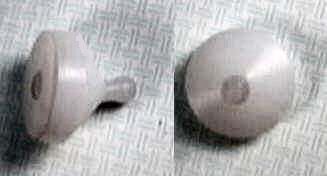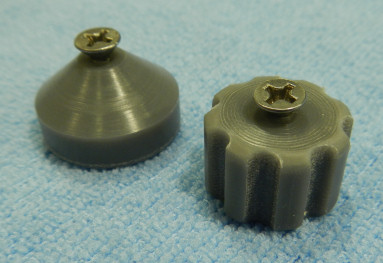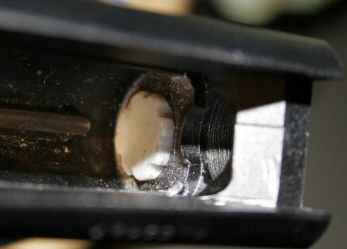

The Franchi parts were (I think)
made out of cast Cast Nylon
6, not a very good material. It yellowed and became brittle over time.
The tit that held the part in finally broke off on most of them,
with the rest suffering a fracture of the whole part into shards. Nylon
is great for easily, cheaply molded parts, but they just don't last. It has an impact strength of
around 0.4 ft.-lbs./in. and hardness of around Rockwell R115.
It is not uncommon for me to hear about a brand new SPAS12 right out of the box to be fired and break the shock absorber with the first shot.

Since I am machining each part, I can use a much better material. The new parts are made of Ultra High Molecular Weight (UHMW) Polyethylene. This material has about the highest impact strength of any plastic at any price -- and what we want is Impact Strength.

Impact
Strength -- The ability of a material to withstand shock loading. Determined
by the notched Izod test, which measures the effect on a
material
when it is suddenly impacted by a swinging pendulum. A larger number signifies
greater impact resistance.
Note almost four times the impact strength of "unbreakable" Polycarbonate. One Hundred times the impact strength of Cast Nylon. I offer a lifetime warranty against the part splitting or shattering. You can take one of my shock absorbers and attack it with a 15-pound sledge hammer -- you will not damage it.
I am using a special type called Oil-Filled UHMW Polyethylene. This has oil impregnated within the Polyethylene. This actually doubles its tensile strength and lets it survive down to -450° F. The oil helps to make anything contacting slides and does not stick and dig in.

This does not need the metal
load spreading steel disk on the factory part. The "old style" had
no disk, but often broke up. They added the disk to the new part to
try and get their Nylon to survive. The superior material I am using
will not break up under any circumstances and needs no disk.
Also, the new part is held in by a stainless steel screw from the other side
rather that the "tit" that always broke off. The "tit" helped with quick
mass assembly -- the screw will last much longer.

